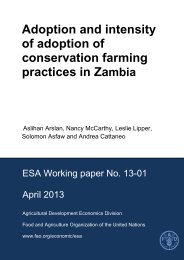Adoption and intensity of adoption of conservation farming practices in Zambia
Adoption and intensity of adoption of conservation farming practices in Zambia
Adoption and intensity of adoption of conservation farming practices in Zambia
Create successful ePaper yourself
Turn your PDF publications into a flip-book with our unique Google optimized e-Paper software.
EXECUTIVE SUMMARY<br />
This paper contributes to literature on agricultural technology <strong>adoption</strong> by us<strong>in</strong>g a novel data<br />
set that comb<strong>in</strong>es data from two large-scale household surveys with historical ra<strong>in</strong>fall data to<br />
underst<strong>and</strong> the determ<strong>in</strong>ants <strong>and</strong> the <strong><strong>in</strong>tensity</strong> <strong>of</strong> <strong>adoption</strong> <strong>of</strong> Conservation Farm<strong>in</strong>g (CF)<br />
<strong>practices</strong> <strong>in</strong> <strong>Zambia</strong>. Conservation agriculture (CA), def<strong>in</strong>ed as practic<strong>in</strong>g m<strong>in</strong>imum soil<br />
disturbance, cover crops <strong>and</strong> crop rotation, has the technical potential to contribute to food<br />
security <strong>and</strong> adaptation to climate change. It has been actively promoted <strong>in</strong> seven <strong>of</strong> <strong>Zambia</strong>’s<br />
n<strong>in</strong>e prov<strong>in</strong>ces s<strong>in</strong>ce the 1980s <strong>in</strong> the form <strong>of</strong> CF <strong>in</strong>clud<strong>in</strong>g plant<strong>in</strong>g bas<strong>in</strong>s <strong>and</strong> dry season<br />
l<strong>and</strong> preparation <strong>in</strong> addition to the 3 CA <strong>practices</strong>. Rigorous analyses <strong>of</strong> the determ<strong>in</strong>ants <strong>of</strong><br />
<strong>adoption</strong>/dis-<strong>adoption</strong> <strong>of</strong> these <strong>practices</strong>, however, are still scarce. This paper fills this gap<br />
us<strong>in</strong>g panel data from two rounds <strong>of</strong> the Rural Incomes <strong>and</strong> Livelihoods Surveys that were<br />
implemented <strong>in</strong> 2004 <strong>and</strong> 2008 as well as (district level) historical ra<strong>in</strong>fall estimate (RFE)<br />
data obta<strong>in</strong>ed from the National Oceanic <strong>and</strong> Atmospheric Adm<strong>in</strong>istration’s Climate<br />
Prediction Center (NOAA-CPC) for the period <strong>of</strong> 1996-2011. We specifically analyse the<br />
<strong>adoption</strong> <strong>and</strong> dis-<strong>adoption</strong> <strong>of</strong> two ma<strong>in</strong> components <strong>of</strong> CF: m<strong>in</strong>imum soil disturbance <strong>and</strong><br />
plant<strong>in</strong>g bas<strong>in</strong>s. Consider<strong>in</strong>g that the Eastern Prov<strong>in</strong>ce has historically received the bulk <strong>of</strong><br />
the CF support activities, we also do our analyses separately for this prov<strong>in</strong>ce to assess the<br />
effectiveness <strong>of</strong> these activities. We document high levels <strong>of</strong> dis-<strong>adoption</strong> (around 95%) <strong>of</strong><br />
these <strong>practices</strong> <strong>in</strong> the whole country, while dis-<strong>adoption</strong> <strong>in</strong> the Eastern prov<strong>in</strong>ce – the hub <strong>of</strong><br />
CF projects <strong>in</strong> <strong>Zambia</strong> – is significantly lower. Nationwide only 5% <strong>of</strong> the households<br />
practiced m<strong>in</strong>imum soil disturbance/plant<strong>in</strong>g bas<strong>in</strong>s <strong>in</strong> 2008, down from 13% <strong>in</strong> 2004, which<br />
raises the question <strong>of</strong> the widespread suitability <strong>of</strong> this practice. Eastern prov<strong>in</strong>ce is the only<br />
prov<strong>in</strong>ce with a significant <strong>in</strong>crease <strong>in</strong> <strong>adoption</strong> rates between the survey years: 14% <strong>in</strong> 2008,<br />
up from 8%.<br />
Our econometric analyses based on panel data methods that control for time-<strong>in</strong>variant<br />
household characteristics fail to provide evidence for the <strong>of</strong>t mentioned determ<strong>in</strong>ants <strong>of</strong><br />
<strong>adoption</strong> <strong>in</strong> the literature. We f<strong>in</strong>d no evidence for the role <strong>of</strong> labor constra<strong>in</strong>ts, age or<br />
education <strong>in</strong> <strong>adoption</strong> decisions. These results suggest that most socio-economic variables are<br />
correlated with household level un-observables (e.g. farmer ability or openness to <strong>in</strong>novation)<br />
<strong>in</strong> cross-sectional studies confound<strong>in</strong>g the effects <strong>of</strong> variables <strong>in</strong>cluded <strong>in</strong> analyses. We do,<br />
however, f<strong>in</strong>d that the <strong><strong>in</strong>tensity</strong> <strong>of</strong> <strong>adoption</strong> is negatively affected by l<strong>and</strong> per capita – another<br />
<strong>in</strong>dicator <strong>of</strong> labor constra<strong>in</strong>t.<br />
We f<strong>in</strong>d a very strong <strong>and</strong> robust relationship between the district level variation <strong>in</strong> historical<br />
ra<strong>in</strong>fall dur<strong>in</strong>g the grow<strong>in</strong>g season <strong>and</strong> <strong>adoption</strong> as well as the <strong><strong>in</strong>tensity</strong> <strong>of</strong> <strong>adoption</strong> <strong>of</strong> the CF<br />
<strong>practices</strong> <strong>in</strong> question <strong>in</strong> <strong>Zambia</strong>. This f<strong>in</strong>d<strong>in</strong>g suggests that farmers are us<strong>in</strong>g m<strong>in</strong>imum<br />
tillage/plant<strong>in</strong>g bas<strong>in</strong>s as a strategy to mitigate the risk <strong>of</strong> ra<strong>in</strong>fall variability, provid<strong>in</strong>g<br />
evidence – albeit <strong>in</strong>directly – <strong>of</strong> a synergy between these <strong>practices</strong> <strong>and</strong> adaptation to climate<br />
variability. Inasmuch as the <strong>practices</strong> analysed here are essential to the CF package, the<br />
results are <strong>in</strong>dicative for the <strong>adoption</strong> <strong>of</strong> the whole CF package as promoted. Further research<br />
is needed to directly assess whether CF decreases yield variability over time as suggested by<br />
these f<strong>in</strong>d<strong>in</strong>gs.<br />
Another robust f<strong>in</strong>d<strong>in</strong>g is that the reach <strong>of</strong> extension services <strong>in</strong> a village (i.e. the proportion<br />
<strong>of</strong> households that received <strong>in</strong>formation on m<strong>in</strong>imum tillage) positively affects both <strong>adoption</strong><br />
<strong>and</strong> the <strong><strong>in</strong>tensity</strong> <strong>of</strong> <strong>adoption</strong>. A key outst<strong>and</strong><strong>in</strong>g question however, is the degree to which<br />
extension services <strong>in</strong>cluded the provision <strong>of</strong> subsidized <strong>in</strong>puts, which is not possible to<br />
dist<strong>in</strong>guish <strong>in</strong> this dataset. Underst<strong>and</strong><strong>in</strong>g the respective importance <strong>of</strong> <strong>in</strong>formation <strong>and</strong><br />
v



